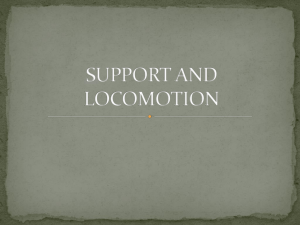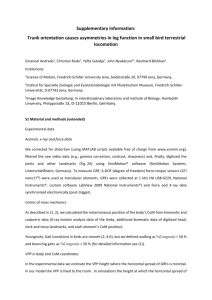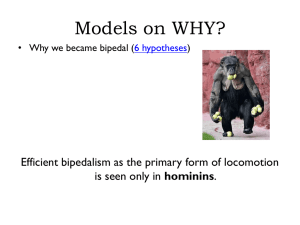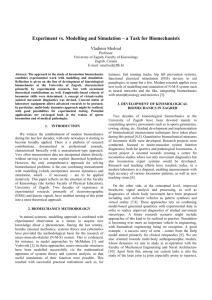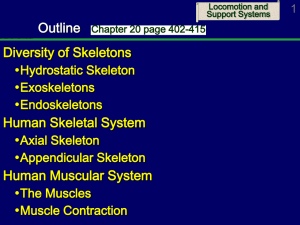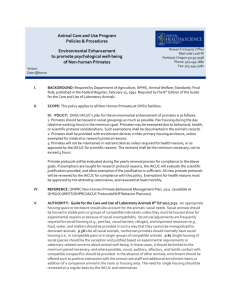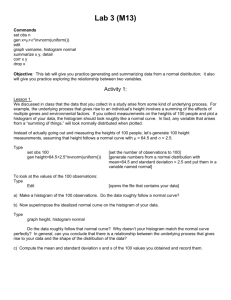A comparative look at the energetic efficiency of bipedal locomotion
advertisement
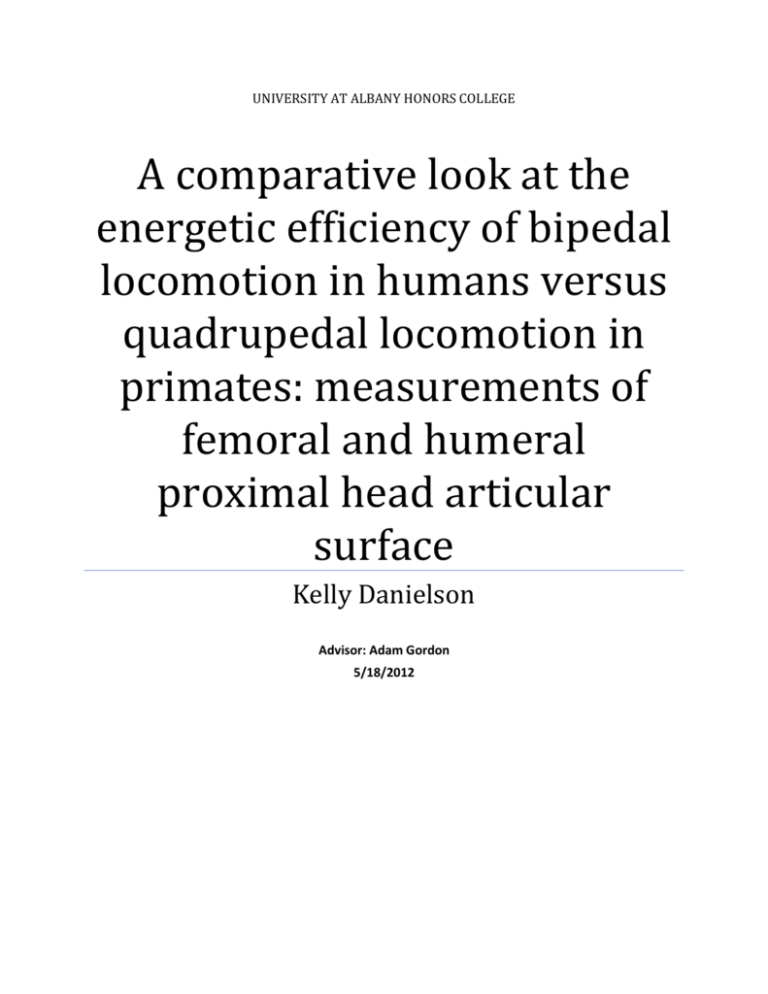
UNIVERSITY AT ALBANY HONORS COLLEGE A comparative look at the energetic efficiency of bipedal locomotion in humans versus quadrupedal locomotion in primates: measurements of femoral and humeral proximal head articular surface Kelly Danielson Advisor: Adam Gordon 5/18/2012 Introduction: The field of Anthropology has always shown great interest in comparing human locomotion and skeletal structure to primate locomotion and skeletal structure. It is widely known that humans developed their bipedal gait and locomotion through millions of years of evolution from primates. Many studies have looked at how the two types of locomotion, bipedal in humans and habitually quadrupedal in primates, differ and how the skeletal structure of humans and primates affect their preferred type of locomotion. Specifically, there has been research done on which type of locomotion would be more efficient and how the skeletal structure has affected the energy efficiency of both. Although both humans and primates have a similar skeletal structure, there are still marked differences in size and shape that have been shown to affect locomotion. In this study, the size of the femoral head and humeral head in Homo sapiens was compared to two different kinds of primates, Cercocebus torquatus and Cercocebus albigena. Using computerized scans of the bones, measurements were taken of the humeral and femoral head and then compared using statistical analysis. It can be hypothesized that because humans are habitually bipedal creatures, they would have a larger femoral head articular surface than humeral articular surface. Similarly, in primates, because they are habitual quadrupeds, it could be expected that they would have similar sized articular surfaces in their femoral head and humeral head. If anything, they would have larger humeral articular surface because they use their upper limbs more when swinging from trees. On that same note, because humans use two larger joints instead of four smaller joints for locomotion, it can be predicted that human bipedal locomotion would be more energetically efficient that primate quadrupedal locomotion. Humans are more bipedal creatures and put a majority of their weight on just their femoral head instead of both femoral and humeral heads. This could also account for the idea that humans would have a greater difference in size between femoral head and humeral head than primates, with femoral head being markedly bigger. Quadrupedal primates need to use all four joints in order to walk, so energy is expended at all four, and therefore more energy is expended. These primates would also have similar sized femoral and humeral head sizes. With the background knowledge that humans are bipedal creatures and place a majority of their weight, when walking, on the femur, it can be hypothesized that the ratio of the size of humeral head to femoral head would be smaller than the ratio in primates. Primates are quadrupedal animals and use all four limbs when walking, so they disperse their weight throughout four joints instead of two. Therefore, the ratio of the size of the humeral head to femoral head would be bigger than in humans. Background The field of anthropology has come up with numerous reasons as to why humans evolved from primates millions of years ago. Modern humans have many observable differences from other primates and these differences have been the main focus of many studies as to the reasons for evolution. Two differences in particular are the type of locomotion that each habitually use and the skeletal structure of each species that allows them to employ that type of locomotion. Humans are known to be habitual bipedal mammals, which mainly use their two lower limbs to move about their environment (Schmitt, 2003) in a diagonal sequence walking gait (D'Aout, Vereecke, et al., 2004). Most primates, Cercocebus torquatus and Cercocebus albigena in particular, are known to be quadrupedal mammals that use all four limbs to move about their environment (Flannery, 2007). Bipedal locomotion Bipedal locomotion, as stated above, is the primary method humans employ to move around their environment. To go more into detail about bipedal locomotion, it is important to point out that there are two forms of bipedal locomotion: walking and running. To be “walking” requires that at least one foot is in contact with the ground at all times, whereas for “running”, both feet can be off the ground for a limited amount of time simultaneously (Milton 2009). Obligate bipedal locomotion was one of the most significant adaptations to occur within the hominid lineage (Harcourt-Smith & Aiello, 2004). Highly specialized postcranial adaptations, especially in the lower limb, characterize this unique form of locomotion (Harcourt-Smith & Aiello, 2004). Although a lot of differences between bipedal locomotion and quadrupedal locomotion are in the bones of the foot, there are still some observable differences present in the lower limb, including those in the femur (Harcourt-Smith & Aiello, 2004). Quadrupedal locomotion Quadrupedal locomotion can be found in many types of mammals, including primates. This type of locomotion uses a lateral-sequence walk, unlike the diagonal sequence seen in bipeds (D'Aout, et al., 2004). Quadrupedal locomotion in primates has been found to be somewhat different than quadrupedal locomotion used by other mammal. Primate quadrupeds extend their limbs further forward at touch down and retract their hind limbs more than other placental mammals. They also tend to place their front feet more in front of their head, instead of right below their eyes, like in other mammals. This could be because they are using quadrupedal locomotion in trees, which requires a different type of movement in order to stay balanced on the tree branches. Therefore, these differences in primate quadrupedal locomotion compared to the quadrupedal locomotion of other mammals more advantageous when spending most of their time in trees (D'Aout, et al., 2004). Energy Efficiency Full human bipedal locomotion was present about 1.6 Myr (Foley & Elton, 1998). Since then, bipedal locomotion has been found to have many advantages over quadrupedal locomotion, including increased manual dexterity, enhanced neural and general thermoregulation, decreased locomotor energetic expenditure, greater anti-predatory vigilance, intra-specific display, and many other (Foley & Elton, 1998). According to Darwin, natural selection and evolution occur when one trait is more advantageous than the other. On land, bipedalism seemed to have more advantages over quadrupedalism, which is why humans evolved as bipedal creatures. Modern humans have also been found to be more energetically efficient than primate quadrupeds in different modern day studies. In a study done by Sockol et. al., humans’ walking was found to be about 75% less costly than quadrupedal or bipedal walking in other primates (Sockol, Raichlen & Pontzer, 2007). This variation in cost can be attributed to biomechanical differences in anatomy and gait, specifically the decreased cost of human walking can be attributed to our more extended hip and longer hind limb (Sockol, Raichlen & Pontzer, 2007). Another study looked at this difference in energy cost and found similar results. A study done by Steudal-Numbers (2003) measured the rate of oxygen consumed by a subject under a variety of locomotor conditions. This was done under the pretense that ongoing submaximal locomotion is powered almost entirely by ATP generated by aerobic pathways, so the amount of oxygen consumed would be proportion to the cost of locomotion. The cost of locomotion is the cost to engage in the activity for a particular amount of time. She too found that human walking uses less energy than that of nonhuman primates. She also found that although there is a direct relationship between body mass and amount of energy needed for locomotion, humans have the largest log body mass and the smallest cost of transport to walk (Steudel-Numbers, 2003). These two studies are some of the many studies that prove human bipedalism is more energy efficient than primate quadrupedalism. The advantage of bipedal walking and reducing the cost of locomotion was apparent in the Miocene, when cooler drier climates increased the distance between food patches (Sockol, Raichlen & Pontzer, 2007), forcing mammals to forage farther in order to find sufficient amounts of food. Size proportions of femoral and humeral head The different types of locomotion that humans and primates employ have a corresponding relationship to their skeletal structure. In humans, more mass and stress is passed through the femur, as compared to the humerus, the effect of which has been the focus of many studies. Christopher Ruff has found that growth of the femur and humerus in humans has been affected by the habitual use of bipedalism. He found that in humans, bipedality involves placing a heavier load on the lower limb, which increases joint size and decreases shaft dimensions (Ruff, 2003). Would the increasing size of the femoral head correspond with a decreasing size in humeral head due to less stress and load placed on it? Thomas R. Rein, Terry Harrison, and Christoph Zollikofer also performed a study on the effects of quadrupedalism on the primate skeleton. According their findings, the articular surface of the humerus was measured and used in an equation, along with the measurements from other points on the humerus to determine humeral torsion, which is the best predictor or quadrupedalism (Rein, Harrison & Zollikofer, 2011). If there is a lower degree of humeral torsion, it is likely that skeletal adaptations to quadrupedalism in the thorax and shoulder girdle have taken place (Rein, Harrison & Zollikofer, 2011). Because of these skeletal adaptations that have been found to correspond with quadrupedalism, would the relationship between humeral head articular surface and femoral head articular surface be smaller than expected? Would it be more similar to that of humans? Primate Subjects Background Information Cercocebus torquatus C. torquatus, more commonly known as White-collared Mangabey, is a tall, slender, agile primate typically found in a wide range of habitats, from swamp forests to agricultural areas in many different parts of Africa (Tooze, 2001). They primarily move about their environment using quadrupedal locomotion, but can occasionally go into the trees to fetch food or sleep (Flannery, 2007). In this study, 12 of these primates were looked at, 4 of which were females, and 8 of which were males. For each of these primates, the humerus and femur were scanned and measured. Cercocebus albigena C. albigena, more commonly known as grey cheeked mangabey, is similar to C.torquatus in that they can typically be found in a variety of habitats all over Africa. They too move about their environment using quadrupedalism (Ham, 1994). In this study, 15 of these primates were looked at, 7 of which were female and 8 of which were males. For each of these primates, the humerus and femur were scanned and measured. Homo sapiens H.sapiens, commonly referred to as humans, have a type of locomotion defined as bipedal. In this type of locomotion, humans place all of their body weight on one leg at a time, until they swing the other leg under their body and then that leg becomes the supporting leg. This type of locomotion is what sets humans apart from their primate ancestors. (Schmitt, 2003). In this study, one human femur and one human humerus were scanned and measured, to be used as a model for humans. The scans for the human bones were taken of plastic models of actual human models, not the actual bones themselves. Methodology: This study compared the articular surfaces of the proximal humeral head and femoral head of Homo sapiens, C. torquatus and C. albigena. In order to do so, computerized scans of the mangabey bones from the Powell-Cotton collection were scanned onto the computer using a laser scanner and loaded onto a computer program, “Microscan.” This program was used throughout the first portion of the study to clean up the bones scans in order to be measured using another computer program later on. For the human humerus and femur, a laser scanner was used to create a computerized image onto the Microscan computer software. This was done by setting up the sensor and connecting the laser to the end. The laser was then used to scan the bone that was held in a clay block. It was important that just the laser was moved when scanning the bone to avoid skewing the image on the computer. Scans were taken from four sides of the bone, once moving the scanner up the bone and once going down. Then, two scans were taken of the top of each bone. The scans were shown on the computer screen and checked to make sure all parts of the articular surface of each bone were scanned and showed up on the image on the computer. The same thing was done to the primate bones; however, it was done using bones from the Powell Cotton museum and scanned onto the computer by Adam Gordon. The bones were then uploaded from the laser scanner to the computer and into the Microscan program. There were double images of the bones, because clay had to be used to hold the bone in place for scanning, so two images of the bone were taken so that each end of the bone was scanned. Using Microscan, first the excess data from the scans that were from the clay or dirt/dust were deleted by highlighting the parts to be deleted with the select tool (button A on the picture below) and then pressing the delete button. Once this was done from both scans of the individual bones, the next step was to place points on each scan of the bone, in corresponding places, so that the computer could merge the images, creating one merged scan of each bone. This was done by clicking the “register” button (labeled B below) and placing at least three of the dots on corresponding parts of each image of the bone. It was important to make sure that the points placed on the bones corresponded exactly to each other, or else the merged image would be skewed. The next step in this process was to smooth out the image. There were a few steps that were required in order to do this. First, the data was converted into points by pressing the “pointcloud” button (labeled C), which turned the bone scan into a point cloud. Next, the computer would clean up the point cloud (button D), by scanning for points that were outliers and then deleting them. This was also done manually in case there were large portions of points that were present but weren’t actually part of the bone. This was done a few times in order to make sure all the outlying points were found and deleted, however it was important to make sure that points that were part of the bone were not deleted as that would create holes in the bone scan. Once the point clouds were cleaned up, the computer again made it into a complete bone scan and then smoothed out (button E). This “smoothing” process was done about three times in order to ensure that the bone scan was completely smooth, however this was another problem spot. If the bone was smoothed too much, then important contours on the bone were smoothed out. The final step was to triangulate the scans using button F. Once triangulating was complete, the scans were saved and moved to another computer in order to measure using another computer program. C A B (Image of Microscan screen #1) D F E (Image of Microscan screen #2) Using the computer program “Amira,” the bone scans were uploaded and measured. First, the bone scans were brought up on the screen and the part of the bone that was not needed for measurement was manually deleted from the scan, using buttons labeled #1 and 2 below. This step was done by pressing button A on the picture below first, which opens the scan in a way that parts of the bone can be deleted. The parts to be deleted were highlighted and then deleted by clicking “surface”, then “edit” and then “delete highlighted faces.” Because this research focused on the articular surfaces of the proximal femoral and humeral heads, all other parts of the bone were deleted so only the articular surfaces of the proximal heads were left. Once that was done, the program measured the articular surface of both bones using a surface area function and read out the results. These measurements were then recorded on an excel spreadsheet and graphed. To get the measurements, right click on the name of the bone on the left side of the screen (labeled A) and left click on “measure” and select “surface area.” A screen will pop up with the measurements for the surface area. “Surface” button #1 #2 A Calculations/Analysis Once all of the measurements were collected and recorded on Excel, a few tests were done to analyze the measurements. First, the interspecific measurement error was calculated to find the percent error between each measurement of the same bone in the same species. The minimum and maximum error between these measurements was recorded along with the average. Then, a regression analysis was done on the bones. This was used to find the slope and intercept of the measurements. Next, a t test was performed in order to find the mean, t statistic, and p value; all of which will be discussed at length in the results and discussion. Problems There were many sources of error in this research process. The first few were from cleaning up the bone scans using the Microscan program. The first possibility for error arose in the first step of cleaning up in the scans, which was when the excess data from the clay and other dust particles were deleted. It was a possibility that part of the bone was deleted and therefore altered the scan. A similar error could have been made when deleting the outlying points later in the point cloud. There could have also been an error when placing the points on corresponding parts of the bone when merging the two original bone scans together to make a single bone scan. Although the computer program did have applications to help eliminate or decrease some of these errors, the possibility of errors is still present. In the next part of the study, where the bones were uploaded into the Amira program, more room for error arose when deleting the excess bone from the scan, leaving what just needed to be measured. It is within reason that some of the articular surface might have been erased or other parts of the femoral and humeral head that were not part of the articular surface were left and measured. This could have skewed the measurements of each of the bones, and altering the results. Results: In this study, all measurements were collected and recorded into Excel spreadsheets in order to perform different statistical analyses. There were overall six sets of measurements taken; the proximal head of the humerus and femur of the three different species. Once all of these measurements were taken, the interspecific measurement was calculated for each bone for each species (see appendix). The minimum, maximum, and average absolute value interspecific measurement errors were calculated, and found to be (all in percentages) (See figure below) Interspecific Measurement Error Species Bone Minimum Maximum Average Homo sapiens Humerus -0.003623739 0.003377571 0.002415826 Homo sapiens Femur Cercocebus torquatus Humerus -0.279882531 0.060331659 0.038941628 Cercocebus torquatus Femur Cercocebus albigena Humerus -0.072759956 0.072863043 0.02538042 Cercobecus albigena Femur -0.015055228 0.014025306 0.010036819 -0.062124098 0.035767778 0.018718091 -0.05541722 0.035607283 0.014721333 Figure A: The minimum, maximum, and average error for both bones of each species. After the interspecific measurement errors were all calculated and recorded, a regression analysis was performed on the two primate species, C. torquatus and C. albigena. This regression analysis found the slope of log Humerus versus log Femur of C. torquatus and C. albigena to be 0.75 (with a 95% confidence interval of 0.497-1.008) and 1.261 (95% confidence interval of 0.906 to 1.616) respectively. The intercept for C. albigena was -0.797, with a 95% confidence interval between -1.767 and 0.174. For C. torquatus, the intercept was 0.747, with a 95% confidence interval between 0.057 and 1.437. Finally, a t test was done to compare H. sapiens to the two primate species. The one measurement of the log of the ratio of the humerus divided by the femur was used as the mean for an online calculation and the log ratios of the two primate species were used as the variables. In this t test, the p value was found to be less than 0.0001, the actual mean was 0.0805, and the t statistic was 22.3105. Discussion: Cercocebus torquatus and Cercocebus albigena are known to be habitual quadrupedal primates, meaning that they employ all four limbs in locomotion. Because of this, it was easy to hypothesize that the size of the articular surface of the humerus and femur were going to be very similar and this is exactly what was found. However, it was interesting to see that the average size for femoral head articular surface was still slightly larger than the articular surface on the humeral head. For example, the average size of the femur for C. torquatus was about 548mm while for the humerus, the average size of the articular surface was about 457mm. This could mean that these primates still pass most of their weight through their hindlimbs or possibly do practice bipedalism temporarily. There is some room for error in all measurement, however, the average interspecific measurement error was below 2% for both bones in each species, so any error that may have arose did not significantly alter the results. This is important because although everything was done multiple times to ensure accuracy, there is always room for human error, which could skew the results. The average interspecific measurement error being below 2% helps to prove that the measurements were accurate. For Homo sapiens, it was found that the average size of the articular surface of the femur was about 4903mm, whereas, the average size of the humerus was about 2762mm. This is a more significant difference, and because of the average interspecific measurement error being below 2%, it is reasonable to conclude that these results are accurate. The next step in the analysis of the measurement was to perform a linear regression on the different primate species. The linear regression found that the slope of a plot of log femur versus log humerus for C. albigena was 1.261 (figure 1 below) with a 95% confidence interval of 0.906 – 1.616, which includes 1.261. The intercept was -0.797, with a 95% confidence interval of -1.767 – 0.174, which includes -0.797. This means that the slope does not differ from isometry at alpha = 0.05. Log H Log F Line Plot 2.8 2.7 2.6 2.5 Log H 2.6 2.65 2.7 2.75 2.8 2.85 Linear (Predicted Log H) Log F Figure 1: Linear regression plot for C. albigena. Slope = 1.261 For C. torquatus (figure 2), the slope was found to be 0.75, which was between the 95% confidence interval of 0.497 – 1.008. The intercept of 0.747 was also found to be between the 95% confidence interval of 0.057 – 1.437. This means that the slope does not differ significantly from isometry at alpha = 0.05. Log F line Plot Log H 2.9 2.8 Log H 2.7 2.6 2.5 2.6 2.7 2.8 2.9 Linear (Predicted log H) Log F Figure 2: Linear regression plot for C. torquatus, slope = 0.75 An important note worth mentioning is the space in the graph between one scatter of plots and another. This separation may be due to the fact that some of the primates that were measured were males, while others were females. The females are known to be smaller in size than males because of sexual dimorphism, which is the reason for the space between plots on the graph. The main point behind this study was to find out if the ratio of the size of the articular surface of the humeral and femoral head of two species of primates was different compared to humans, and if so, what was that difference? The graph below (figure 3) shows the disparities between humans and primates. Notice how C. torquatus and C. albigena have relatively the same ratio and are smaller than that of the H. sapiens model. H. sapiens were found to have larger articular surfaces of both the humeral head and femoral head and the ratio of the humeral head to femoral head was smaller than in non-human primates. A smaller ratio can be translated to mean that there is a larger difference between the sizes of the two articular surfaces, the bottom variable (femoral head) being much larger than the top variable (humeral head). This finding was consistent with what was expected in the hypothesis. Ratios of log H/logF C. Torquatus 5.5 C. albigena 5 H. sapiens LOG F 4.5 Linear (C. Torquatus) 4 Linear (C. albigena) 3.5 3 2.5 2 2 2.5 3 3.5 4 4.5 5 5.5 LOG H Figure 3: Comparison of the ratio of log H/log F for each species The one tailed t test was performed for this study comparing the one measurement for H. sapiens to both primate species. This test compared the log ratios of the humerus divided by femoral articular surfaces of each species. It was found that because the t stat was significantly large, Homo sapiens and both primate species are statistically different and from two different populations and therefore resulted from two different ancestors. Conclusion: This study was set up to test the hypothesis that the size difference between the articular surface of the humeral head would be significantly smaller than the femoral head in Homo sapiens compared to two quadrupedal primates; Cercocebus torquatus and Cercocebus albigena. After taking numerous measurements and analyzing those measurements using different programs on Excel, it was found that this hypothesis was true. In fact, the size of the articular surfaces in both bones was markedly larger in human bones than both primate species and the ratio of the two was much smaller in humans. According to previous studies, the differences in size could be due to the fact that more weight was passed through the femoral joint than humeral joint in humans when they use bipedal locomotion, whereas in quadrupedal locomotion, the weight was more evenly distributed between all four limbs. The even weight distribution would result in more equal sized articular surfaces in the femoral and humeral heads. In the future, more research could be done into size differences in different parts of the bone, for example, if the shaft of the femur or humerus is different in size in species using different types of locomotion. It would be interesting to see if other parts of the bone are affected as well as the articular surface. Works Cited: D'Aout, K., Vereecke, E., Schoohaert, K., De Clercq , D., Van Elsacker, L., & Aerts, P. (2004). Locomotion in bonobos ( pan paniscus ): differences and similarities between bipedal and quadrupedal terrestrial walking, and a comparison with other locomotor modes. Journal of Anatomy, 204, 353-361. Retrieved from http://web.ebscohost.com/ehost/pdfviewer/pdfviewer?sid=5216f5e3-58a5-4baf-8da7f66ba006d218@sessionmgr104&vid=8&hid=107 Flannery, S. (2007). White-collared mangabey (cercocebus torquatus). Retrieved from http://www.theprimata.com/cercocebus_torquatus.html Foley, R. A., & Elton, S. (1998). Time and energy: the ecological context for the evolution of bipedalism. Primate locomotion:recent advances, (1998) Ham, R. M. (1994). Behvaiour and ecology of grey-cheeked mangabeys (cercocebus albigena) in the lope reserve, gabon. Thesis: Department of Biology @University of Stirling, Retrieved from https://dspace.stir.ac.uk/handle/1893/2191 Harcourt-Smith, W. E. H., & Aiello, L. C. (2004). Fossils, feet, and the evolution of human bipedal locomotion. Journal of Anatomy, 204, 403-416. Retrieved from http://web.ebscohost.com/ehost/pdfviewer/pdfviewer?sid=5216f5e3-58a5-4baf-8da7f66ba006d218@sessionmgr104&vid=6&hid=107 Milton, J. G. (2009). Introduction to focus issue:bipedal locomotion- from robots to humans. CHAOS, 19, Retrieved from http://web.ebscohost.com/ehost/pdfviewer/pdfviewer?sid=5216f5e3-58a5-4baf-8da7f66ba006d218@sessionmgr104&vid=5&hid=107 Rein, T. R., Harrison, T., & Zollikofer, C. P. E. (2011). Skeletal correlates of quadrupedalism and climbing in the anthropoid forelimb: implications for inferring locomotion in miocene catarrhines . Journal of Human Evolution, 61, 564-574. Retrieved from http://www.sciencedirect.com/science?_ob=MiamiImageURL&_cid=272603&_user=681852&_ pii=S0047248411001655&_check=y&_origin=&_coverDate=30-Nov2011&view=c&wchp=dGLbVBA-zSkWb&md5=50910e74932903fb6dcfce9bbb264fb8/1-s2.0S0047248411001655-main.pdf Ruff, C. (2003). Ontogenetic adaptation to bipedalism: age changes in femoral to humeral length and strength proportions in humans, with a comparison to baboons. Journal of Human Evolution, 45, 317-349. Schmitt, D. (2003). Insights into the evolution of human bipedalism from experiemental studies of humans and other primates. The Journal of Experimental Biology, (206), 1437-1448. Retrieved from http://jeb.biologists.org/content/206/9/1437.full Schmidt, M. (2005). Quadrupedal locomotion in squirrel monkeys (cebidae: Saimiri sciureus). AMERICAN JOURNAL OF PHYSICAL ANTHROPOLOGY, 128, 359–370. Retrieved from http://onlinelibrary.wiley.com/doi/10.1002/ajpa.20089/pdf Sockol, M. D., Raichlen, D. A., & Pontzer, H. (2007). Chimpanzee locomotor energetics and the origins of human bipedalism. Proceedings of the National Academy of the Sciences of the United States of America, 104(30), 12265-12269. Retrieved from http://www.pnas.org/content/104/30/12265.full.pdf html Steudel-Numbers, K. L. (2003). The energetic cost of locomotion: humans and primates compared to generalized endotherms. Journal of Human Evolution, 44(2), 255-262. Retrieved from http://www.sciencedirect.com/science/article/pii/S0047248402002099 Tooze, Z. (2001). Cercopithecidae - genus cercocebus - red-capped mangabey: cercocebus torquatus torquatus. Retrieved from http://www.cercopan.org/Primates/mangabey.htm Appendix: Cercocebus torquatus (measurements) ID CAM I 18 m39 m59 M69 m 71 m77 m80 m81 m84 m102 m103 m115 Measurement #1 Femur Humerus (Area) (Area) 676.59 553.94 621.86 618.02 647.46 641.14 707.28 617.42 625.37 585.39 506.81 364.63 739.14 610.85 465.605 394.692 468.946 380.948 471.118 364.644 693.44 501.95 564.95 551.2 Measurement #2 Femur Humerus (Area) (Area) 676.71 574.71 640.08 619.35 655.39 590.28 732.06 601.63 671.2 578.85 497.597 347.056 769.27 565.32 448.897 371.962 467.756 360.504 474.942 389.924 716.86 534.06 592.74 525.25 Measurement #3 Femur Humerus (Area) (Area) 706.31 591.35 659.32 603.79 657.21 635.18 732.2 611.14 648.19 586.28 513.85 380.266 746.29 552.11 482.23 378.44 426.022 366.483 461.194 364.643 714.52 510.04 559.96 522.88 Cercocebus torquatus interspecific measurement errors: ID CAM I 18 m39 m59 M69 m 71 m77 m80 m81 m84 m102 m103 m115 #1 Femur -0.014 #2 #3 #3 0.029 #1 #2 Humerus -0.034 0.002 0.031 Averages Femur Humerus 0.019 0.023 -0.014 -0.029 -0.009 -0.023 -0.035 0.001 -0.017 0.000 0.032 0.004 -0.021 -0.013 -0.001 0.003 0.011 0.035 -0.017 0.024 -0.036 0.030 0.012 0.012 0.035 0.030 0.006 0.012 0.000 0.015 -0.007 0.036 -0.062 -0.017 0.009 -0.022 0.007 0.030 0.012 0.003 0.002 0.060 0.034 0.032 -0.023 -0.026 0.034 -0.057 0.021 0.002 -0.096 0.045 -0.042 -0.187 -0.008 -0.023 -0.280 -0.019 0.020 0.006 0.015 0.024 0.011 0.016 0.024 0.041 0.011 0.014 0.024 0.009 -0.051 -0.014 -0.008 -0.047 -0.019 -0.026 -0.024 0.045 0.036 -0.015 0.024 0.034 0.009 0.036 0.031 0.040 0.082 0.021 0.030 0.114 0.023 Cercocebus albigena (measurements) ID FC11 8 m157 m339 m355 m371 m561 m668 m683 m706 m721 m749 m788 m807 m852 m997 measurement #1 Femur Humerus 608.59 479.72 Measurement #2 Femur Humerus 591.34 517.31 Measurement #3 Femur Humerus 611.34 555.06 472.574 591.98 471.214 558.64 463.179 616.43 602.87 534.01 420.614 652.9 584.52 473.548 631.49 466.102 497.431 598.82 493.819 567.15 507.19 629.06 599.53 540.19 446.224 661.52 601.3 457.199 641.45 465.754 480.605 591.04 476.141 550.4 500.69 639.67 613.72 532.95 444.338 641.8 580.77 441.051 630.1 474.942 399.004 537.26 387.693 576.5 374.846 529.57 531.76 400.494 348.619 576.33 500.61 418.246 598.49 332.81 374.16 483.654 366.038 550.05 354.877 477.161 517.69 387.542 348.857 550.77 467.864 411.792 569.7 332.524 Interspecific measurement errors for C. albigena #1 #2 #3 #1 #2 ID Femur Humerus FC118 0.008 -0.021 0.013 -0.073 0.000 m157 -0.023 0.029 -0.006 0.012 -0.051 m339 -0.003 0.008 -0.005 0.054 -0.051 m355 -0.019 0.028 -0.009 0.009 -0.047 m371 0.000 0.015 -0.015 0.056 0.008 m561 -0.055 0.034 0.021 0.021 -0.033 m668 -0.019 0.001 0.018 0.048 -0.055 m683 -0.004 -0.010 0.014 0.017 -0.010 m706 -0.003 0.008 -0.005 0.036 0.002 m721 -0.038 0.021 0.017 -0.005 -0.004 m749 0.001 0.014 -0.016 0.028 -0.018 m788 -0.007 0.021 -0.014 0.019 -0.047 m807 0.036 0.000 -0.035 0.010 -0.006 m852 -0.005 0.011 -0.007 0.040 -0.010 m997 -0.006 -0.007 0.013 0.003 0.002 #3 0.073 0.038 -0.003 0.038 -0.064 0.012 0.007 -0.006 -0.038 0.009 -0.011 0.028 -0.004 -0.029 -0.005 409.343 508.23 398.805 510.94 371.575 508.74 519.63 372.044 353.347 554.66 504.97 412.473 559 330.019 Averages Femur Humerus 0.014 0.049 0.019 0.034 0.005 0.036 0.019 0.031 0.010 0.043 0.037 0.022 0.013 0.037 0.009 0.011 0.006 0.025 0.025 0.006 0.011 0.019 0.014 0.032 0.024 0.007 0.007 0.026 0.009 0.004

